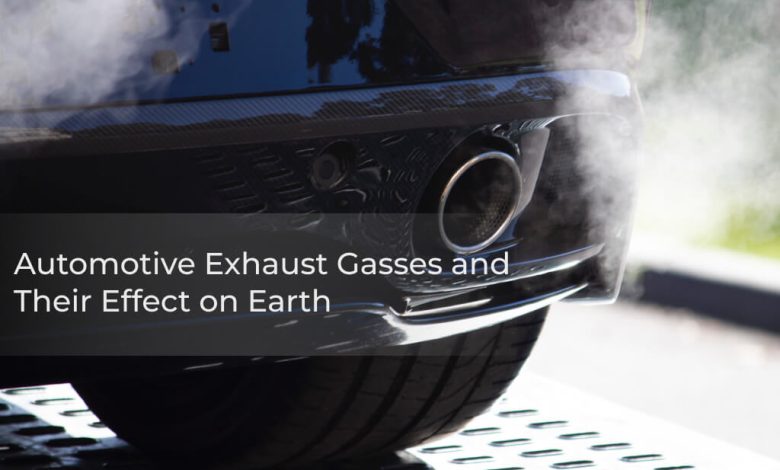Automotive Exhaust Gasses & Their Effect on Earth

Exhaust gasses (off-gasses) are the waste substances of combustion inside the engine, They are products of oxidation and incomplete combustion of hydrocarbon fuel. Emissions of exhaust gasses are the main reason for excess of admissible concentration of toxic substances and carcinogens in the atmosphere of the large cities, formations of the smogs which are the frequent reason of poisoning in self contained spaces. The amount of pollutants released into the atmosphere by vehicles is determined by the mass emission of gasses and the composition of the exhaust gasses.
Chemical components contained in the exhaust gasses have a harmful effect on various human organs. Pollution of the atmosphere leads to a decrease in oxygen and an increase in carbon dioxide, which entails a number of stable weather changes. Researches of scientists show that from year to year the maintenance of carbonic gas in the atmosphere increases. This leads to the so-called “greenhouse effect”, i.e. an increase in the average annual temperature on the planet by an average of 0.8-3%, which, in turn, will lead to significant climate changes.
Carbon dioxide (CO2 )
Carbon monoxide (CO)
Hydro-carbon (HC)
Nitrogen oxides (NOX)
Sulphur Oxides (SOX)
Ozone (O₃)
Aldehydes (CH3CHO)
Particulate Matters & soot (C)
Compounds of lead & other metals.
Table: Exhaust gasses, their harmful effects and remedy.
| Sl. | Name | Ecologically harmful effects | Technical solutions. |
| 1 | Carbon dioxide, CO2 | Carbon dioxide is the main component in the exhaust gasses of the engine, creating a greenhouse effect in the atmosphere (greenhouse gas). | It can be controlled by improving combustion processes & catalytists. |
| 2 | Carbon Monoxide, CO | Toxic effect on humans and animals | Optimization of the combustion process of fuels. Application of additives |
| 3 | Sulfur oxides, SOX | Irritation of respiratory system; acid rain formation. | Development of fuels with reduced sulfur content destruction of catalytic converters. |
| 4 | Nitrogen oxide, NOX | Irritation of respiratory system; Catalytic reduction of nitrogen oxides in the formation of acid rains and smog; combustion products participation in the destruction of the ozone screen | Catalytic reduction of nitrogen oxides in the formation of acid rains and smog; combustion products |
| 5 | Hydrocarbon HC | Carcinogenic action; Reduction of saturated vapor pressure of fuels; participation in the creation of the optimization of the combustion process, the greenhouse effect, the formation use of additives of ozone and smog | Reduction of saturated vapor pressure of fuels; optimization of the combustion process, the use of additives. |
| 6 | Ozone O₃ | Toxic effect on flora and fauna; participation in smog formation | Reducing the emission of ozone-forming substances: hydrocarbons and nitrogen oxides. |
| 7 | Aldehydes (RCHO) | Irritant effect on organisms; participate in the formation of smog. | Improving the combustion process |
| 8 | Particulate matter C | Carcinogenic action, participation in the formation of smog and acid rain. | Decrease in ash content of fuels, reduction of sulfur and aromatic hydrocarbons content. |
| 9 | Compounds of lead and other metals | Toxic effect on flora and fauna; violation of the balance of microelements in water and soil; poisoning of afterburning catalysts. | Development of fuels that do not contain metal compounds. |
Purification of exhaust gasses of vehicles.
There are several methods of purifying of exhaust gasses, the most common & usefull method is catalysts on the metal and ceramic blocks The methods used to reduce the toxicity of exhaust gasses from spark-ignition engines fall into two main categories. 1) Design methods 2) Exhaust gas purification The known methods for reducing the toxicity of exhaust gasses can be represented in the form of the following scheme.
Fig. Methods for reducing the toxicity of exhaust gasses (EG) from internal combustion engines (ICE).
During last years the works of the D. Mendeleev University of Chemical Technology (Russia) are aimed at the creation of effective multicomponent catalyst compositions of complex composition such as Au/Ce0.72Zr0.18Pr0.1O2 or Me0.1Zr0.18Ce0.72O2, where ‘Me’ is the rare earth metal and methods for their application to ceramic honeycomb carriers. This trend corresponds to trends in world practice. They created a method for the synthesis of a cerium-containing catalyst, comprising 20-50% by wt. of cerium dioxide, 15-35% by wt. of zirconia, and the remainder – oxides of rare earth elements is considered. The compound was prepared by co-precipitation of metal hydroxides in an aqueous medium with ammonium hydroxide. To purify carbon monoxide and organic derivatives in the presence of nitrogen oxides, the authors of proposed a multicomponent solid solution with the spinel structure AB2 O4 , where A is Zn0.18-0.21Cd0.18- 0.21Co0.18-0.63Fe0,02-0.46 and B is Cu0.09-0.36Ni0.09-0.11Cr0.24- 0.48Fe0.28-0.34. Complete detoxification occurs at temperatures of 460-560°C. The catalyst has a high thermal stability.
Modern neutralizers, developed, for example by Ukrainian scientists, provide for a multistage technology for cleaning the exhaust gas engine, consisting of:
1) Particulate filters from synthetic cordierite honeycomb structure with a formed catalytic coating in the form of complex oxides of copper, chromium, cobalt, deposited on aluminum oxide.
2) Effective catalysts for three-routing transformations (CO/CnHm/NOx ) – (Pd, Pt, Rh) -REE (La, Ce)/γ-Al2 O3 /cordierite.
3) Neutralizers developed on the basis of processes of selective reduction of nitrogen oxides (I, II) on structured catalysts using reductants of different chemical nature: ammonia, vanadium-titanium and oxide compositions (Cu, Fe, Cr/Al2O3), C1-C4 hydrocarbons and carbon monoxide (CoO/ (HZSM-5/Al2 O3 )/cordierite, CoO/ZrO2 /caolinaerosil, Pd/Co3 O4 /CeO2 /cordierite).
Conclusion:
It is very important to reduce emissions of NO2 and particulate matter (soot), carrying out qualitative tests of catalysts in real conditions for obtaining more complete information on the operation of catalytic converters. It is necessary to tighten regulatory emissions in a legislative way because the purification of exhaust gasses from motor vehicles and chemical industries is a scientific, technical and social problem.



